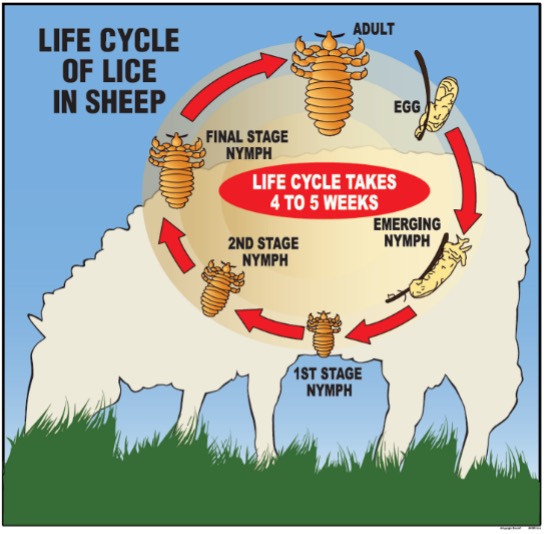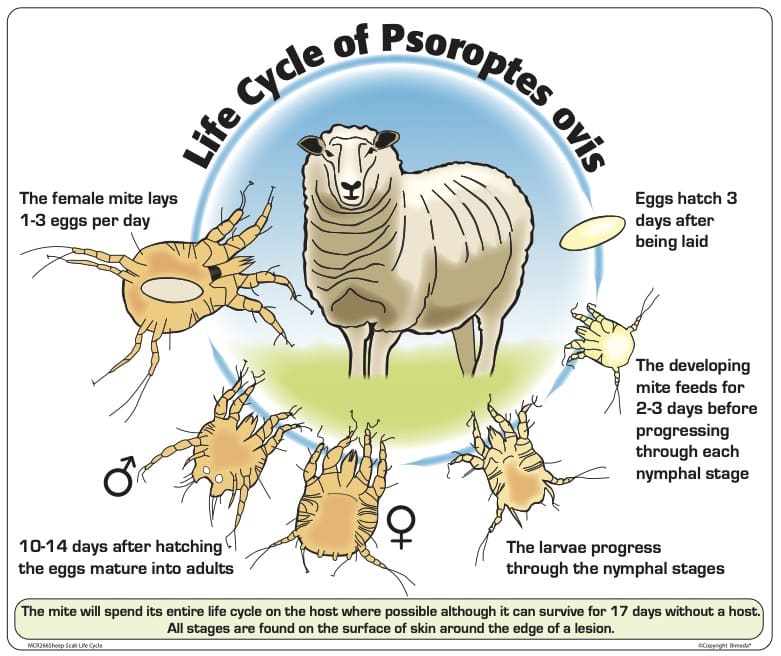Itchy sheep? Is it Scab? Lice? And How Can You Tell The Difference?
This information is provided by Bimeda, makers of Ectofly 12.5mg/ml Pour-on Solution for Sheep.
Have you noticed clinical signs in your flock such as:
- Rubbing against fences?
- Wool tags left behind on fencing?
- Scratching with hind legs?
- Nibbling themselves?
- Pulled wool or wool loss?
Any of the above clinical signs warrants further investigation. Ectoparasites, such as lice or scab, could be responsible and it is critical to differentiate between them. You cannot tell, just by looking, whether sheep have lice, scab or both!
How can you differentiate?
Contact your vet who can advise on the most effective way to differentiate between sheep scab and lice. Hair pluck and skin scrape samples can be collected to check for the presence of lice (adults and/or eggs) and sheep scab mites.
In some cases, even when sheep scab mites are present, they may not be detected by skin scraping simply as the burden may be low (but growing). Your vet may also advise the collection of blood samples which can be checked for antibodies to sheep scab disease. This blood test allows earlier detection of scab disease than scraping.
Lice
 Chewing lice affect sheep in the UK and use their mouthparts to feed on skin debris. They thrive in warm, thick fleeces and so we tend to see the burden gradually increase over the winter months. Generally animals in good condition are able to keep the burden in check but animals in poor health tend to suffer the most.
Chewing lice affect sheep in the UK and use their mouthparts to feed on skin debris. They thrive in warm, thick fleeces and so we tend to see the burden gradually increase over the winter months. Generally animals in good condition are able to keep the burden in check but animals in poor health tend to suffer the most.
If lice are diagnosed by your vet, there are 4 medicinal choices licenced for treatment (table 1). When determining which approach is most suitable for your flock consider the following:
- Fleece length- in fully fleeced sheep one treatment with a pour on/spot on product may not be effective
- The impact of withdrawal periods
- Whether treatment is practically possible e.g. if you plan to dip, do you have a certificate of competence and means of licenced disposal?
Discuss with your vet or SQP (RAMA) for further information.
Table 1: Medicines licenced for the treatment of lice in sheep
| Active ingredient | Parasites treated | Meat withdrawal |
|---|---|---|
| Cypermethrin | Lice, ticks, blowfly & headfly | 8 days |
| Alpha-cypermethrin | Lice, ticks, blowfly & headfly | 49 days |
| Deltamethrin | Lice, ticks keds and established strike (maggots) | 35 days |
| Diazinon | Lice, sheep scab, blowfly, ticks and keds | 49 days |
Sheep scab
 Sheep scab costs the UK sheep sector £78-202 million annually1 and is caused by the Psoroptes ovis mite which can be transmitted between animals and via the environment on fomites e.g. clothing. It is able to survive for up to 17 days in the environment, for example in wool caught on fences.
Sheep scab costs the UK sheep sector £78-202 million annually1 and is caused by the Psoroptes ovis mite which can be transmitted between animals and via the environment on fomites e.g. clothing. It is able to survive for up to 17 days in the environment, for example in wool caught on fences.
The mites produce faeces eliciting a severe allergic reaction on the sheep host, causing skin lesions and intense itching. While many are familiar with the classic signs of scab fewer are familiar with the signs of chronic sheep scab disease, and unaware that long-term infections may cause no obvious clinical signs at all.
If sheep scab is diagnosed, engage with your vet or RAMA (SQP) to discuss treatment options.
There are currently two treatment groups available- plunge dipping with organophosphate dip or injecting with Macrocyclic Lactones (group 3 clear wormers).
Table 2: Medicines licenced for the control of sheep scab in the UK:
| Category | Active | Additional information |
|---|---|---|
| Organophosphate (plunge dipping) |
Diazinon | Treatment: dip once Prevention: 60 days |
| Macrocyclic lactones (injectable) |
Ivermectin | Treatment: two injections 7 days apart Prevention: none Route: subcutaneous |
| Doramectin | Treatment: one injection Prevention: none Route: intramuscular |
|
| Moxidectin 1% | Treatment: two injections 10 days apart Prevention: 28 days Route: subcutaneous |
|
| Moxidectin 2% | Treatment: one injection Prevention: 60 days Route: subcutaneous |
Note: Diazinon is not licenced for use in showers/jetters and should only ever be used in a plunge dip.
For further support with itchy sheep- speak to your vet or SQP (RAMA) who will be able to provide up to date advice.
Use Medicines Responsibly. Noah.co.uk/responsible. Ectofly 12.5mg/ml Pour-on Solution for Sheep is a POM-VPS medicine containing 12.5mg/ml cypermethrin licenced for blowfly, lice, headfly and ticks. Further information should be sought from the prescriber. Bimeda can be contacted on +44 (0)1248 725 400. Further information is available from the SPC on the VMD website.